Art Fairs
art berlin 2017: Has Berlin’s Art Fair Finally Grown Up?
After years of existential crisis, Berlin has banded with Cologne in an attempt to save its failing art fair. Did it work?
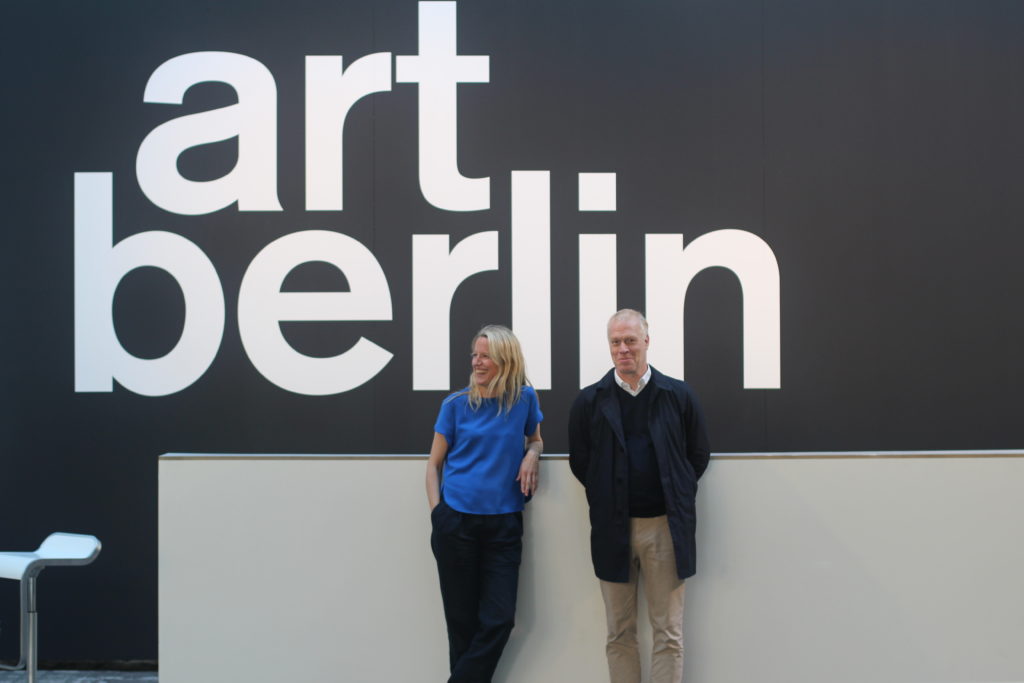
After years of existential crisis, Berlin has banded with Cologne in an attempt to save its failing art fair. Did it work?

Kate Brown

It’s the same time, same place, and same old feeling—mostly. At the newly christened art berlin 2017, everything is familiar and new at once. Fair director Maike Cruse and her new collaborator Daniel Hug of Art Cologne are floating around looking self-assured, despite finding themselves in uncharted territory, since Koelnmesse announced it would be purchasing the fair earlier this spring. It is unusual for one city’s art fair to take ownership over another, but the two are decidedly not awkward about their newfound relationship.
“We really wanted to take this step: to become a more classical art fair,” Cruse told artnet News. “While we loved art berlin contemporary, and it was very hard to let it go, we see so many advantages and opportunities to explore with this change.”
“It’s not placing Cologne over Berlin, or Berlin over Cologne, but rather bringing the two most important centers in Germany to work together and cooperate,” Daniel Hug told artnet News. “It is about creating a bridge between these divergent art scenes that have developed over time.”
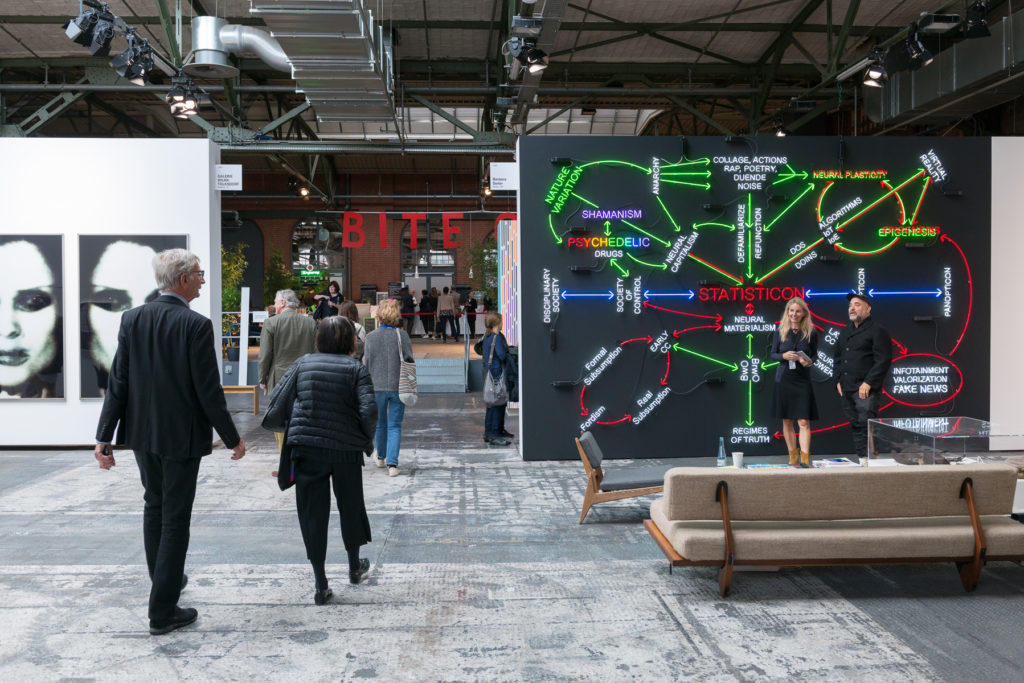
Warren Neidich at Barbara Seiler. Photo Stefan Korte.
It was time for some sort of change, for sure. The 2016 edition of abc had become a ghost of its former self, with only 62 galleries and slow sales reported. After last year’s slump, participating galleries were growing skeptical.
“Every year until April or May, we were wondering what the concept was going to be, if should we actually do it, or if should we cancel it,” Cruse explained. “Our structure didn’t allow us to build or function in a sustainable, long-term way.”
With 112 galleries this year from 16 countries, the fair has reached its old size again, but whether this will translate into sales has yet to be determined.
Now that Art Cologne has stepped in, the anti-booth concept that was signature to previous iterations of the now-defunct art berlin contemporary (abc) has been scrapped, and the old mail depot-cum-exhibition hall was lined with beaming white booth walls, row upon row.
Some speculate whether the move was in anticipation of MCH Group’s impending infiltration of regional art fairs like Art Düsseldorf. “They can’t make a fourth Basel, so they have to find other ways to grow,” Daniel Hug told artnet News, “They decided against Berlin of course and went for Düsseldorf, and I always like a challenge. I think Berlin has the most potential of any place.”
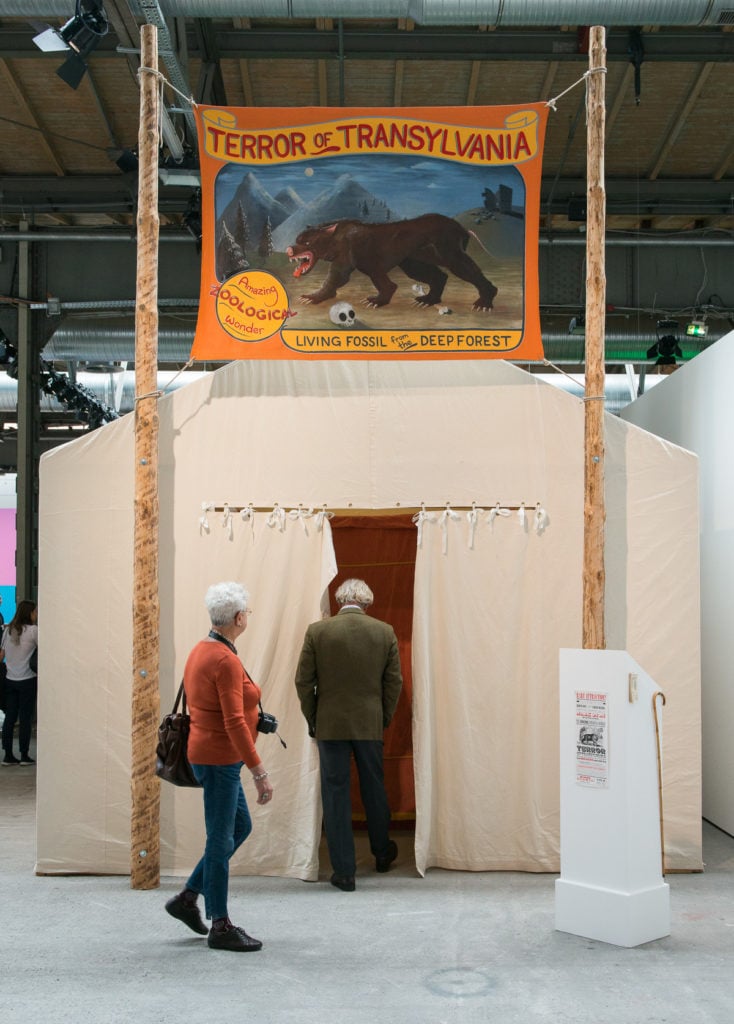
Installation View of Monster, 1998 by Marc Dion at Nagel Draxler. Photo Stefan Korte.
Where previously there had been exclusively solo presentations of contemporary works from a younger demographic of artists, the rules have now opened up, and many galleries responded by opting for a curation of multiple artists per presentation. The expanded format also included Modern art from secondary market dealers for the first time ever, and a large black, white, and red work from Gilbert & George at Michael Schultz (a new addition from Berlin this year) was drawing attention from fair-goers on preview day.
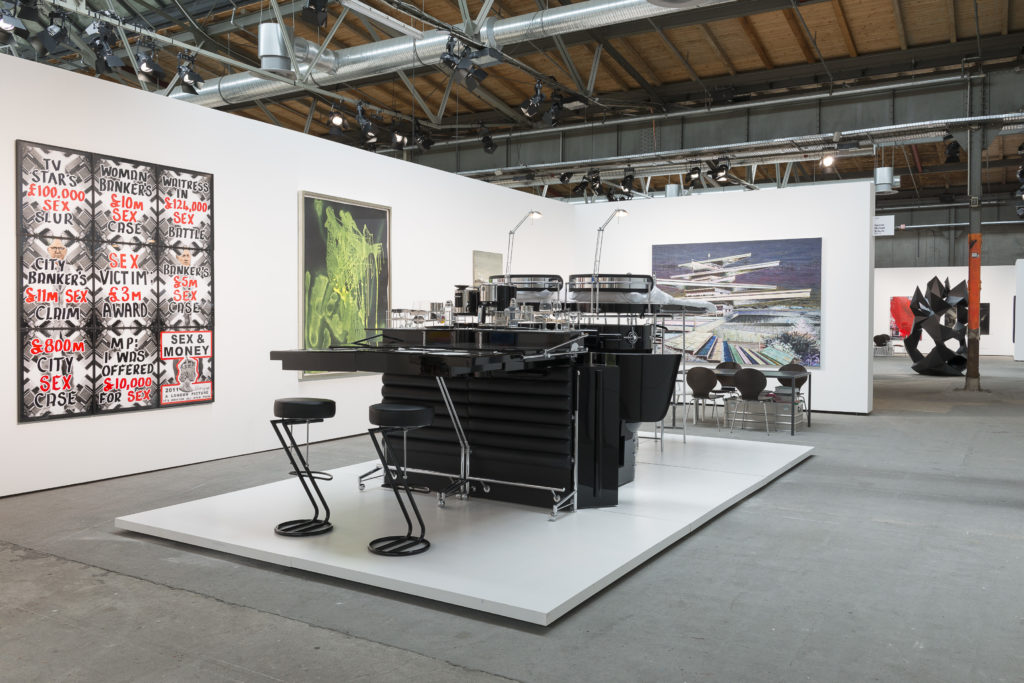
Installation view of Galerie Michael Schultz. Photo Stefan Korte
This presence of Modern art came in large part from notable galleries who traveled from Germany’s wealthier Rhineland region (bringing some notable collectors with them, like Gil Bronner from Düsseldorf who was seen strolling the fair). Newcomer Schwarzer Galerie, also from Düsseldorf, was offering a 2002 Gerhard Richter artist proof for €138,000, and an iconic Sigmar Polke had an even bigger price tag of €275,000—prices way above the usual price point at the fair. Next door, at Klaus Benden Gallery, a cornerstone exhibitor at Art Cologne, Tom Wesselmann works were on sale for up to €42,500. By the afternoon of preview day, exhibitors didn’t seemed overwhelmed by remarkable sales or elite collectors.
Still, there were many impressive exhibitors. Standout booths came from younger galleries like Soy Capitán, who featured a two-person presentation by Grace Weaver and Camilla Steinum. Weaver’s melancholic peering figures, which included a large-scale sculpture by the artist who is, up until now, known best for her paintings, were a poetic pairing with Steinum’s wall-hanging textiles that featured loosely figurative, reclining bodies. Tobias Naehring from Leipzig also stood out with a mixed booth, punctuated by a large smoking cigarette sculpture by Wilhelm Klotzek, titled An der Ecke (On the Street Corner). “I expected nothing, but we made some sales and there was a lot of interest,” Naehring told artnet News at the end of evening.
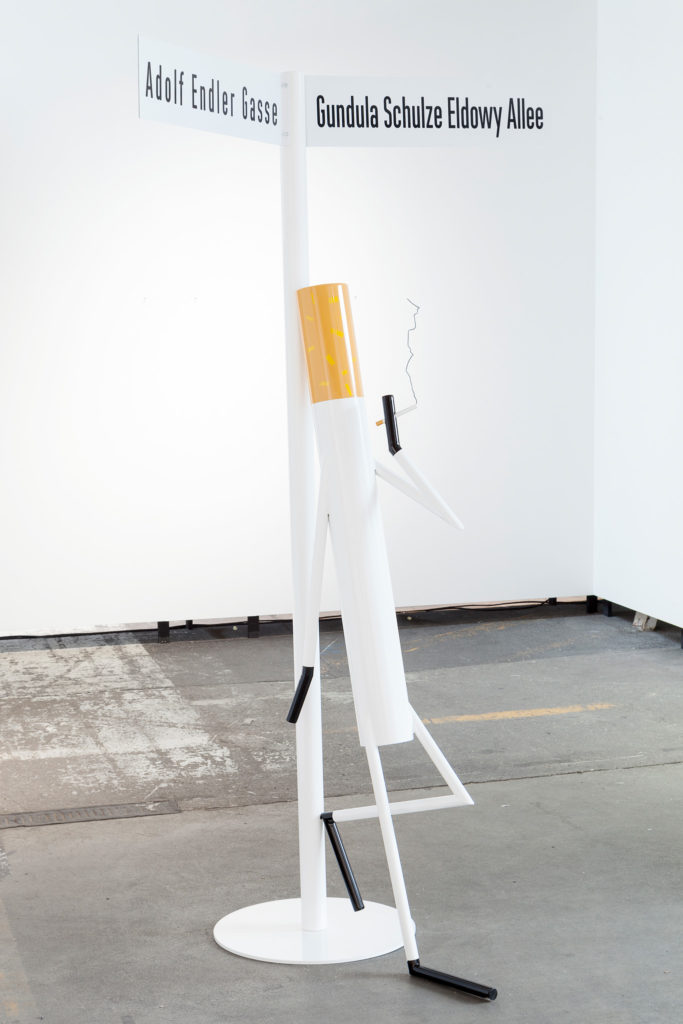
Wilhelm Klotzek, An der Ecke, 2017 at Tobias Naehring. Photo Daniel Poller.
Several Berlin galleries abided by abc’s tradition of solo presentations. Highlights included Sprüth Magers’ immersive, hilarious, and foreboding installation by John Bock (which extended right onto the bodies of the gallerists in the form of a fuzzy green arm sleeve) and a larger-than-life crafted chain dangled from the ceiling rafters at Zilberman Gallery’s solo presentation of Turkish artist Azade Köker. Brazilian artist Adriano Costa combined an intriguing array of ephemera in his wall pieces, on view at Berlin-based Supportico Lopez, one of the new locally-based participants this year. “This time it is stronger and there’s more structure,” the gallery’s co-founder Gigiotto Del Vecchio told artnet News at the closing of preview day. But the gallerist could still see room for improvement: “I think this fair really needs to have a more international audience and more international galleries,” he added.

Installation view of John Bock at Sprüth Magers. Photo Stefan Korte.
Indeed, despite the presence of cool younger names and post-war blockbusters, the fair still felt extremely regional. Some galleries tuned into this local feeling, and even Australia’s Neon Parc opted to focus their presentations on Berlin subject matter, showing works by Australian conceptual duo Janet Burchil and Jennifer McCamley made during their residency at Berlin’s prestigious Künstlerhaus Bethanien in the early 90s. Alongside their spatially-minded documentary photoworks, Australian Gerry Bibby continued an ongoing series with two new works referencing Berlin sites like Alexanderplatz, the old East Berlin city center.
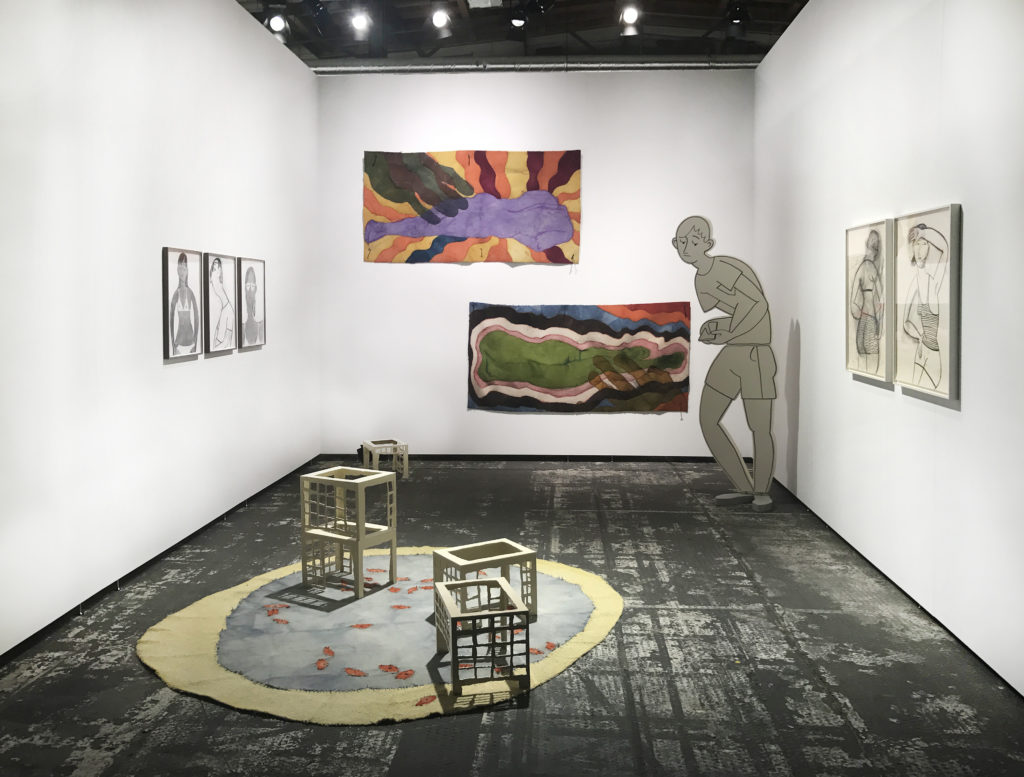
Grace Weaver and Camilla Steinum at Soy Capitán. Photo courtesy Soy Capitán.
Overall, such collaboration between two cities definitely feels like a utopian gesture in times of polarity and upheaval. Without remarkable sales, what was clear by the end of the preview day is that it will take a few years for art berlin to gain an elite following and the international appeal that Art Cologne already enjoys, but Hug feels confident that it will happen.
“I think by building up Berlin it will basically build up Cologne as well: by working closely with it and no longer competing. Supporting the art market in Berlin, supporting the galleries in Berlin, and building up a really strong fair, we can generate a lot of international interest in a short time and make this one of the world’s leading fairs,” Hug stressed.
As many Berlin galleries and resident artists continue to struggle, Hug’s optimistic message sounds very enticing. But only time will tell whether he’s right.
The first edition of art berlin runs from September 14 to September 17 at Station Berlin.